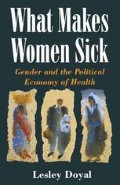Abstract
If women are to maximise their health and their autonomy, they must be able to determine the nature of their reproductive lives (Correa and Petchesky, 1994; Dixon-Mueller, 1993). If they have sex with men, they must have the means to enjoy it without fear of infection or unwanted pregnancy, they must be able to control their own fertility without risking unpleasant or dangerous side effects, and they must be able to pass safely through pregnancy and childbirth to raise healthy children. Men can control their bodies and maintain their health without controlling their fertility. Since women cannot do the same, they have always sought the most effective means of enhancing their reproductive self-determination (Gordon, 1976; Petchesky, 1986).
Preview
Unable to display preview. Download preview PDF.
Further Reading
Hartman, B. (1987) Reproductive Rights and Wrongs: the global politics of population control and contraceptive choice (New York: Harper and Row). An exploration of the relationship between population control and reproductive choice in the third world. This book puts population problems and population policies into a wider social and economic framework in order to assess how health and family planning programmes could better meet the needs of the poor.
Jacobson, J. (1990) The Global Politics of Abortion (Worldwatch Paper 97) and Jacobson, J. (1991) Women’s Reproductive Health: the silent emergency (Worldwatch Paper 102). Taken together these pamphlets provide an excellent introduction to current trends and debates in the area of reproductive health.
Mintzes, B. (ed.) (1992) A Question of Control: women’s perspectives on the development and use of contraceptive technologies (Amsterdam: Women and Pharmaceuticals Project, Health Action International and WEMOS). Available from Women’s Health Action Foundation, PO Box 4263, 1009 Amsterdam, The Netherlands. A collection of papers from a conference of reproductive rights activists held in the Netherlands in 1991. A number of contributors discuss the new hormonal contraceptives and there are case studies from Asia, Africa and Latin America.
Petchesky, R. (1986) Abortion and Women’s Choice: the state, sexuality and reproductive freedom (Verso). A historical and theoretical introduction to the debate about reproductive rights. This detailed analysis of contraception and abortion politics concentrates on experiences in developed countries and offers invaluable insights into the relationship between reproduction and wider feminist issues.
The best sources of women-centred and up-to-date information in this rapidly changing area are Reproductive Health Matters published twice yearly and available from 1 London Bridge Street, London SE1 9SG, England, and Newsletter of the Women’s Global Network on Reproductive Rights, published quarterly and available from NZ Voorburgwal 32, 1012 RZ Amsterdam, Netherlands.
Copyright information
© 1995 Lesley Doyal
About this chapter
Cite this chapter
Doyal, L. (1995). Regulating Reproduction. In: What Makes Women Sick. Palgrave, London. https://doi.org/10.1007/978-1-349-24030-2_4
Download citation
DOI: https://doi.org/10.1007/978-1-349-24030-2_4
Publisher Name: Palgrave, London
Print ISBN: 978-0-333-54205-7
Online ISBN: 978-1-349-24030-2
eBook Packages: Palgrave Political & Intern. Studies CollectionPolitical Science and International Studies (R0)

